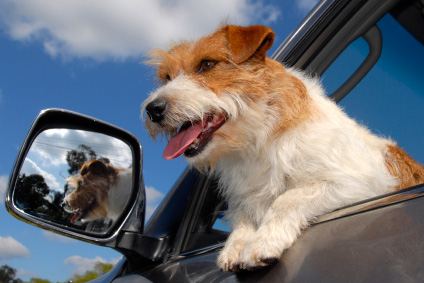Dog harnesses: 5 tips to keep your furry friend safe in the car
Nick DiUlio
Dog owners may be shocked to learn that there has never been a single safety standard for the restraints meant to keep our pooches secure inside the car… until now.
Several months ago, Subaru teamed up with the nonprofit Center for Pet Safety (CPS) to conduct extensive crash tests measuring the effectiveness of car safety restraints for dogs. The study analyzed 12 popular dog harnesses for small, medium and large crash-test dog dummies using three separate tests. The goal was to study the harnesses’ crashworthiness, and how well they prevented the dog from sliding side-to-side or back-to-front.

After uncovering flaws in many of the most popular dog restraints on the market, Subaru and CPS determined that Sleepypod’s Clickit Utility harness performed best. It was the only harness that offered complete protection in the event of a crash and also kept the crash-test dog from launching off the seat.
“Safety for all passengers, including our pets, is very important to Subaru and to our drivers. Selecting the wrong harness could be just as detrimental as not using one at all,” says Michael McHale, director of communications for Subaru.
But harnesses are just one component of safe pet travel. Here are five tips on how to best protect your traveling pooch.
5 tips for keeping dogs safe in the car
1. Avoid distraction
According to the National Highway Traffic Safety Administration (NHTSA), 80 percent of crashes and 65 percent of near-crashes involve some sort of distraction. And while texting usually gets all the attention, dogs in cars can be equally dangerous.
In a 2011 AAA survey, 56 percent of people surveyed said they drive with their dog in a vehicle at least once a month. What’s more, nearly 65 percent admitted to engaging in at least one potentially distracting activity while doing so, including petting their dog or allowing the dog to sit on their laps while driving.
“Being distracted isn’t safe for anyone in the car, including your dog,” says Denise Fleck, a Los Angeles-based animal care instructor and founder of SunnyDogInk.com, a website devoted to pet care. She says that your pet should be properly restrained in the back of the car so he or she is not a distraction.
2. Start with short trips
According to Jessica D’Amato, spokeswoman for the American Kennel Club, not all dogs love riding in cars, which is why owners should get them used to the experience one step at a time.
“Many of the issues dogs face when traveling by car — most notably motion sickness — are caused by anxiety,” D’Amato says. “Before you take Fido on the open road for a long trip, get him used to the car by taking many short trips. And take him to fun places like the dog park so he doesn’t associate the car with going to the veterinarian and groomer only.”
Fleck says it’s also a good idea to feed your dog ginger snap cookies about 20 minutes before any car ride. “The ginger can help settle queasy tummies,” she says.
3. Prepare a pet emergency kit
According to the American Animal Hospital Association, 25 percent more pets could be saved each year if just one pet first aid technique were applied prior to getting to the vet.
Danielle VanDusen, marketing coordinator for BettyBrigade.com, a Michigan-based personal assistance and concierge service that specializes in pet care, recommends dog owners talk to their vets about preparing an emergency pet kit that remains in the car at all times. Some common items will include cotton bandage rolls, bandage tape and scissors, antibiotic ointment, and a pet first aid manual.
“When you take your pets on a trip in the car, you should also make sure you bring an extra supply of their medications as well as their medical paperwork,” VanDusen says. “Keep it all together in a ziplock bag. You never know when you’re going to need it.”
4. Close the windows
While some dogs may delight in leaning out the window to let their ears flap in the breeze, experts say this is a very dangerous behavior.
“(This behavior) makes them susceptible to harmful things like gravel and road debris that might get kicked up and injure the dog’s ears or eyes,” Fleck says. “Also, most people don’t think about this, but the wind can dry out the corneas.”
5. Beat the heat
If you’re only popping into the local convenience store for a minute or two, leaving your dog alone inside the car isn’t a concern. Anything longer than five minutes, however, can spell disaster.
According to Fleck, research suggests that even 72 degrees is too hot for a dog, even with the window rolled down. Leaving them in a hot car for even as little as five or ten minutes can lead to heat stroke, brain swelling and potential organ failure.
“There’s a greenhouse effect that takes place inside a car when sunlight comes through the windows. Also, cars are parked mostly on concrete and asphalt, which radiate heat quickly through the car’s metal exterior,” Fleck says. “The bottom line is this: If your pet can’t come with you on every stop, he’s better off at home.”
See how much you could save today on your car insurance. Get your free auto insurance quotes today!
